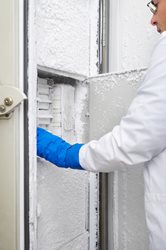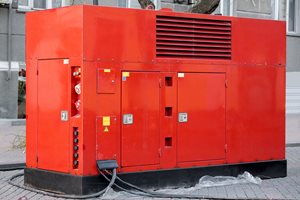Used Generators For Backing Up COVID Vaccine Freezers
The on-going roll out of the COVID-19 vaccines has created a new focus on reliable backup power for ultra-low freezers (ULFs). Generator Source is seeing market demand for small-to-medium sized new and used diesel generators to provide stable and reliable temperatures in the ultra-low freezers used to store COVID vaccines. Companies are investing in Generator Source’s
used industrial generators to keep their vaccine inventory safe when the power grid fails. We are proud to play an important role during this global pandemic as our used industrial generators help millions of people be safely and effectively vaccinated.
COVID-19 Vaccine Storage Considerations
In general, vaccines need to be stored within the manufacturer’s parameters to ensure that they are both safe for use and efficacious upon delivery. Developing manufacturing, transport, and storage parameters is part of the development process for any new drug. As multiple pharmaceutical companies are producing vaccines for the novel Coronavirus 19, the storage considerations vary by manufacturer:
- Moderna COVID-19 Vaccine (Frozen): -25°C and -15°C (-13°F and 5°F)
- Pfizer COVID-19 Vaccine (Frozen): -80°C and 60°C (-112°F to -76°F)
- Johnson & Johnson COVID-19 Vaccine (Frozen): -20°C (-4 °F)
Storing vaccines in a frozen state allows a longer usable shelf life, compared to refrigerated or room temperature storage. Maintaining a supply of vaccines available both doses is essential to the medical supply chain due to the two-dose nature of most COVID vaccines. To maintain the low temperatures required for long-term storage of COVID vaccines, distribution nodes and medical facilities use ultra-low freezers.

What are ultra-low freezers?
Ultra-low freezers (ULFs) are used in medical facilities, hospitals, and laboratories to store materials at temperatures between -45C to -86C*. These freezers typically feature significant insulation and larger compressors than are found on a freezer designed for food use. Additionally, some ULFs have digital temperature displays, data recorders, and/or glass doors for supply monitoring.
Ultra-low freezers are commonly found in the following industries:
- Medical / biological research
- Vaccine supply chain and delivery facilities
- Medical clinics
- Research and development laboratories
- Tuning fish processing
Many freezers can hold as much as 40,000 - 50,000 microtubes of frozen material and come in a variety of sizes. ULFs in critical research may have active temperature and power monitoring, to ensure the stability of samples inside the freezer. Like most other electronic devices, ultra-low freezers are susceptible to power loss.
Lab Refrigerators and Freezers during a Power Outage

When the power grid goes down at a lab or medical facility utilizing ultra-low temperature freezers, the loss in cooling capability may expose the contents to harmful conditions. Though they are well insulated, ultra-low freezers require electricity to run their cooling compressors and without that power, will slowly begin to warm. If the ULF is being used to store COVID-19 vaccines, the samples could begin thawing and the clock will start ticking for their unfrozen shelf life. In situations where the ULF is storing certain chemicals, hazardous or flammable vapors could be produced during the thawing process. Samples inside the freezers may extremely difficult to replace and in some cases took years of hard work and research to create.
Well-prepared organizations prevent the above negative outcomes by investing in reliable power sources to maintain power continuity during an outage. The most common and reliable backup power source is an industrial diesel generator, paired with an automatic transfer switch (ATS). This equipment combination will sense when there is a grid outage and automatically call the generator to begin producing electricity. The investment in a reliable generator can help prevent the spoilage of COVID-19 vaccines due to power outage.
While hospitals are required by NFPA 110 to have sufficient backup power capacity, smaller clinics and outpatient facilities may not be as well equipped. The NFPA requirements were designed ensure that critical facilities, such as hospitals, have redundant generator capabilities to backup life-safety and sensitive medical systems. Small doctor’s offices are not subject to the same stringent requirements but when utilizing ULFs, may have a need to ensure a stable power source in the event of a grid outage.
Industrial generator backup power systems are necessary for ultra-low freezers operations. Many These freezers use compressors and internal systems to keep the samples safe while the power is on, however, when a power outage occurs, these systems cannot keep the freezer at a cold enough temperature to safeguard the vaccines.* Again, this stresses the importance of having a reliable, used industrial backup generator installed at the freezers location.
How much energy does an ultra-low freezer use?
Since these specialized freezers produce low temperatures, they consume relatively high levels of electrical energy per day. According to a recent Colorado College study, UL freezers consume 15 kWH/day to 32 kWH/day. Per year, the average consumption for a ULF is 3,233 to 6,205 kWH*. These statistics measure the overall power consumption, measured in Kilowatt Hours.
Generator Considerations for ULFs
For the real time requirement, electrical power is measured in Kilowatts (kW). The above daily electrical consumptions initially imply a relatively modest 0.6 – 1.3 kW requirement for ULFs. Additionally, the in-rush current of the compressor must be accounted for, which can add 2-3x the requirement, meaning just the ULF might require 1.2 – 4 kW. Planners must further account for other essential systems that run on the same set of circuits, such as lighting, HVAC, and medical equipment. All of the systems that need to run during an outage need to be accounted for in the capacity of the backup generator to ensure that requirements do not overwhelm the generators capabilities.
Home standby generators might seem like an appropriate power source due to their low cost and 12-20 kW capability, but critical facilities should focus on 1800 RPM industrial models for increased reliability. There are many great home standby
(HSB) generators available, but their higher RPM configurations make them slightly less reliable than industrial grade generators.
20 kW industrial generators, such as the MTU 4R0055 DS20 are perfect for backing up small to medium sized medical offices that contain ULF freezers.
The team at Generator Source is here to help with your power needs! Please contact our team to discuss the power requirements for your next project. We will source the best used industrial generator for your needs,
service the generator, load bank the generator, and ship it to your location, hassle free.
Article Sources:
Accucold.com
Lab Manager
Colorado.edu
mediproducts.net
Kyle Smith
| 1/14/2021 9:36:52 AM
|
0 comments